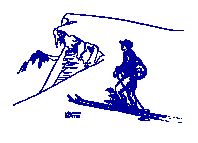
We met at 7:30 AM in the parking lot of the Mammoth Ranger Station. The group signed in and caravaned to Sierra Meadows, a cross-country ski ranch at the base of Sherwin Bowl which was gracious enough to let us use their parking lot for our cars over the weekend. We gathered our gear, put skins on our skis, and assembled for Norm Wilson's introduction to the avalanche course and an overview of the Sherwin Bowl. Norm and Howard led the skipack into base camp on a sheltered slope overlooking Mammoth Lakes. For some participants, this was their first snowcamp.
After setting up camp, we skied to a bench where Norm discussed avalanche safety topics. Soon we got down to the nitty gritty of beacon searches. After tramping around a large area, a beacon was buried in this simulated avalanche, and Norm skillfully demonstrated the correct and efficient procedure for locating a buried beacon.
Breaking up into two groups, everyone got an opportunity to practice. The more enterprising group attempted to locate two buried beacons, which is much more difficult. It reinforced the "safe skiing" rule about skiing one at a time on a slope that is questionable.
The two days were filled with information about evaluating avalanche hazards:
Norm doesn't give much credence to the shovel shear test and feels the Rutschblock test is the most reliable snow pit test. The object is to detect weak layers and assess their strength. After the snowpit is dug, you can use a finger or a credit card running down through the snowpack to locate the various layers. Dedicated avalanche observers, such as Norm Wilson, would include temperature, density, and grain texture analysis of each layer. But I don't feel the need to get that technical in analyzing avalanche hazard. l primarily want to know what will happen on that suspect slope when the weight of a skier is on it. and the Rutschblock test provides this information.
We dug a pit more than 2 meters deep and hit a slushy layer that indicated it had rained in the Sherwin Bowl at our site, followed by heavy snow fall. Although Norm felt we were not at risk, I peered uphill noting the heavily loaded steep slope above us and was glad to be leaving that area and returning to camp!
Since most victims trigger avalanches themselves and since chances of survival are pretty slim after being buried an hour (sometimes this is as short as 5 minutes!), it is important to evaluate the risks and to know how to proceed in a rescue, which Norm covered on Sunday. He showed us how to organize a rescue, do a hasty search, and proceed with a probe line (for a victim without a rescue beacon). Other important field exercises we practiced during the weekend were measuring slope angle, looking at tree growth and lean, looking for decapitated trees and for signs of flagging (trees with no limbs on the uphill side), and observing snow deposition and erosion.
The most important criterion for avoiding avalanche danger is being observant. Look for signs of previous avalanches, recognize avalanche terrain and stick to the high ground when route-finding, note temperature changes, amount of snowfall, and the wind direction and speed. Beside avoiding avalanche terrain, precautions most ski mountaineers take are: carrying beacons, probes, and shovels, crossing one at a time in a suspect zone, removing ski-pole wrist straps, using an avalanche cord, and selecting an escape route. Avalanche hazard is one very good reason to use releasable bindings.
We learned a lot. And guess what! The skiing was wonderful, too!
Safe skiing!
Nancy Gordon